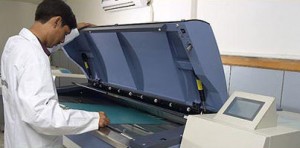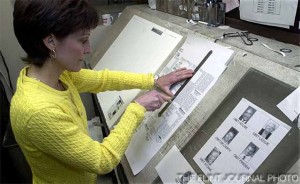Prepress – basic
Prepress is the term used in the printing and publishing industries for the processes and procedures that occur between the creation of a print layout and the final printing. The prepress procedure includes the manufacture of a printing plate, image carrier or form, ready for mounting on a offset printing press, as well as the adjustment of images and texts or the creation of a high-quality print file. In today’s prepress shop, the form of delivery from the customer is usually electronic, either a PDF or application files created from such programs as Adobe InDesign or QuarkXPress.
So before the job can be printed, the document must be converted to film and plates. Film negatives are created from digital files. Images from the negatives are transferred to printing plates in much the same way as photographs are developed. A measured amount of light is allowed to pass through the film negatives to expose the printing plate. When the plates are exposed to light, a chemical reaction occurs that allows an ink-receptive coating to be activated. This results in the transfer of the image from the negative to the plate.
There are different materials for plates, including paper (which produces a lower-quality product). The best plate material is aluminum, which is more costly.
Each of the primary colors — black, cyan (blue), magenta (red), and yellow – has a separate plate. Even though you see many, many colors in the finished product, only these four colors are used (you’ll also hear this called the four-color printing process — it’s a little like the three-color process used in TV).
Prepress processes
The following items have each been considered part of prepress at one time or another:
- Typesetting involves the presentation of textual material in graphic form on paper or some other medium. Before the advent of desktop publishing, typesetting of printed material was produced in print shops by compositors or typesetters working by hand, and later with machines.
- Copy-editing, is the work that an editor does to improve the formatting, style, and accuracy of a manuscript. Copy-editing is done prior to the work of proofreaders, who handle documents before final publication.
- Markup is an artificial language using a set of annotations to text that give instructions regarding the structure of text or how it is to be displayed. Markup languages have been in use for centuries, and in recent years have also been used in computer typesetting and word-processing systems.
- Proofing involves creating an accurate facsimile of the artwork before beginning production runs. This serves as a bond between the printer and their customer that the final product meets an agreed upon standard. Proofs in general can be done for all parts (images, illustrations, texts and colors) of print product. In this part, three types of proofing should be checked and printed out: the print-ready PDF files, the printer’s proof and the imposition proof. Print-ready PDF files should be made after the layout using preflight at the printing house. The printer’s proof should be printed out in high-resolution and checked by the customer. The imposition proof, which is usually done by the printers, should also be printed out to check and adjust the offset printing press.
- Proofreading traditionally means reading a proof copy of a text in order to detect and correct any errors. Modern proofreading often requires reading copy at earlier stages as well.
- Screening and adjustment of a continuous-tone of images such as photographs.
Imposition, or the combination of many pages into a single signature form. - Separation, or specifying images or text to be put on plates applying individual printing media (inks, varnishes, etc.) to a common print.
- Manufacturing of plates The usage of different materials of plates should meet the needs of printing method. Usually rubber, plastic, aluminum are used for plates as well as film which is the photomechanical exposure and processing of light-sensitive emulsion on a printing plate. Manufacturing of plates should be well planned and delivered beforehand. Also, the cost should be calculated as well.
- Manufacturing of a high-quality print (PDF) file, which is used for the final printing.
- Paper select, choosing a proper paper is also a very important step in prepress.
In most modern publishing environments, the tasks related to content generation and refinement are carried out separately from other prepress tasks, and are commonly characterized as part of graphic design. Some companies combine the roles of graphic design and prepress production into desktop publishing usually called DTP.
The set of procedures used in any particular prepress environment is known as a workflow. Workflows vary, depending on the printing process (e.g., letterpress, offset, digital printing, screen printing), the final product (books, newspapers, product packaging), and the implementation of specific prepress technologies. For example, it is not uncommon to use a computer and image-setter to generate film which is then stripped and used to expose the plate in a vacuum frame; this workflow is hybrid because separation and halftoning are carried out via digital processes while the exposure of the plate is an analog one. That demonstrates that the borders around the prepress are very fluid. Furthermore – depending on the printing method and the print product – the elements of the prepress of a graphic print production can differ from case to case. This circumstance requires a management of the workflow. It is necessary to manage the responsibility for each part of the workflow. That can mean that employees, who are actually responsible for other parts of the production (e.g. Layout), have to attend to parts of the prepress.



